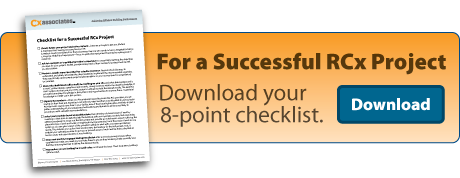As a company that does a good amount of retrocommissioning (RCx) – the commissioning process applied to existing buildings – when taking on a new project we are often faced by a question asked by both ourselves and our clients: “Where do we start?”
Stop Talking, Start Listening
As engineers and generally technically-minded folks, often we are tempted to start answering this question in a technical manner. For example, we might start listing common areas where occupant comfort, system reliability, and energy efficiency may have become deficient as a building ages (or equally likely, were never right from the start!).
Our chief job as guides—as well as technical experts—of the retrocommissioning process, however, is to stop talking and analyzing, and to start by listening. By definition, the processes of both commissioning and retrocommissioning are an owner’s process. This means that to be successful, getting to know the building owner’s historical operating challenges, current and future facility needs (both technically, and as they pertain to the organization’s mission), and benchmarks for implementing a successful project are the highest priorities. The formal documented outcome of this kind of assessment work for RCx is the Current Facilities Requirements (CFR) document, which is the analog to the Owner’s Project Requirements (OPR) for a new construction project. The CFR is intended to “put a stake in the ground” in terms of defining needs for the building at the present time, but also is best utilized as a living document—evolving as the building use and facilities objectives change over time.
Once the retrocommissioning team (owner, commissioning agent, and other stakeholders) have agreed on a set of common goals as defined in the CFR, the nitty-gritty technical energy and operational evaluation can begin.
Multi-Facility Projects: Pick Using Energy Intensity or Pick the Squeaky Wheel
Deciding where to start when looking at retrocommissioning multiple facilities or even a campus can add another level of complexity to navigating the start of an RCx project. As with the approach for a single building, the RCx team first needs to get together and define priorities for multi-building assessment, e.g., what are the most important criteria in selecting the first RCx building target(s)? While every Owner has unique goals, we have found two common approaches to be successful:
- A data-driven approach utilizing the EPA’s Energy Star building rating system to evaluate energy intensity of individual buildings. The system takes inputs of individual building utility billing data, building type and era of construction, and building use type, and provides a score for how the building is performing on an energy basis compared to its “peers” in the market. Once all buildings are scored, these metrics can be used to help identify the biggest energy users and to answer the question of which building to tackle first.
- When we encounter a situation where the facilities of an institutional campus have little-to-no data on individual building energy use from billing sub-metering (the absence of which can making benchmarking nearly impossible), we recommend a different approach. This involves performing short term energy metering using temporary datalogging electric power meters and BTU meters among a handful of the suspected “worst offenders” on campus to pick a good starting point. As a last resort to get quantitative data, we sometimes use publicly available statistical energy use survey data for the particular construction type, building age, and use type, in combination with known building square footage.
While reducing energy use and associated operational cost is often a common goal for owners, reducing operational headaches can be equally if not more important. We can use many different types of quantitative methods to select the biggest energy user out of a selection of buildings, but facilities folks usually already know which buildings are the biggest headaches. One of the benefits of retrocommissioning is that solving problematic operations is always a high priority outcome, which nearly always leads to realizing energy savings as well. Simply picking the “squeaky wheel” building from the perspective of the Owner/Operators can sometimes be the best place to start in a campus or multi-facility RCx project. We always find that if we can solve building owners’ headaches and save them energy and cost at the same time, we can build the foundation to a lasting partnership.





